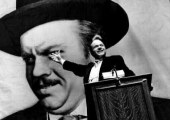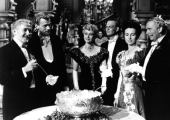|
 El cine en la década de los 40:
El cine en la década de los 40:
[...] Es difícil establecer una unidad en el cine de los 40, pues existen tres períodos. El primero comprende los años 1940 y 1941, antes de que Estados Unidos entrara en la guerra. El segundo abarca hasta el final de la guerra en 1945. El tercero es la posguerra y la recuperación de los cines nacionales europeos. El cine de los 20, terminada la Gran Guerra, es la época de aquella generación de cineastas de todo el mundo que desarrollaron y llevaron a la perfección el lenguaje del cine mudo (imagen y música) establecido en la década anterior por Griffith. Y era un cine internacional, pues bastaba con cambiar el idioma de los rótulos, cada vez menos numerosos.
En los años 30, con el sonoro, surgió el teatro fotografiado. Pero pronto los «herederos de Griffith» aprendieron a utilizar la palabra hablada como complemento de la imagen.
 Los 40, por tanto, son la segunda década del cine sonoro. Pero también suponen el nacimiento del cine moderno: por un lado, el cine que medita sobre su identidad y la identidad de los personajes, y la relación entre actor y personaje, un cine que da a la palabra hablada una importancia desconocida en la década anterior: Orson Welles hace en 1941 Ciudadano Kane; el hombre que «reinventa» el cine es un hombre de la radio. Y, por otro lado, el cine con actores naturales, el cine considerado como instrumento de conocimiento y de comunicación (el neorrealismo y Rossellini: Roma, ciudad abierta fue rodada en 1945).
Los 40, por tanto, son la segunda década del cine sonoro. Pero también suponen el nacimiento del cine moderno: por un lado, el cine que medita sobre su identidad y la identidad de los personajes, y la relación entre actor y personaje, un cine que da a la palabra hablada una importancia desconocida en la década anterior: Orson Welles hace en 1941 Ciudadano Kane; el hombre que «reinventa» el cine es un hombre de la radio. Y, por otro lado, el cine con actores naturales, el cine considerado como instrumento de conocimiento y de comunicación (el neorrealismo y Rossellini: Roma, ciudad abierta fue rodada en 1945).
[La II Guerra Mundial:]
La primera voz que desde América se alzó contra los nazis fue la de Charles Chaplin en El gran dictador (1940). Curiosamente, Chaplin era el único cineasta que todavía no había aceptado el cine «hablado» y ésta fue su primera película hablada, en la que hace un discurso de siete minutos. Se hace cine antinazi: Lubitsch rueda To Be or Not To Be. Y directores europeos se incorporan al cine americano: Jean Renoir, Alfred Hitchcock, Max Ophuls, Douglas Sirk, Fritz Lang, Robert Siodmack, Otto Preminger y Billy Wilder, entre otros.
 Nuevos directores:
Nuevos directores:
John Huston inaugura la serie negra con El halcón maltés (1941). Y después de la guerra surge una nueva generación de cineastas: Nicholas Ray, Elia Kazan, Jacques Tourneur, Joseph Mankiewicz, Anthony Mann, Samuel Fuller, Bud Boetticher o Donald Siegel. La comedia americana está representada en estos años por personalidades como McCarey y Preston Sturges. En 1948, Vincent Minnelli rueda El pirata con Gene Kelly, y este último codirige con el joven Stanley Donen en 1949 Un día en Nueva York.
Western:
John Ford, que en el año 40 y 41 había conseguido su segundo y tercer Oscar por Las uvas de la ira y Qué verde era mi valle, vuelve al western con Pasión de los fuertes y Fort Apache. Howard Hawks dirige en 1948 Río Rojo. Y King Vidor, junto con O'Selznick, inaugura el super-western: Duelo al sol. En esta década, el cine pierde a tres cineastas importantes: Lubitsch muere el 30 de noviembre del 47, Eisenstein el 11 de febrero de 1948 y Griffith el 23 de julio de 1948. (Antonio Drove)
 Sullivan's Travels. Preston Sturges (1941):
Sullivan's Travels. Preston Sturges (1941):
Sullivan is a successful, spoiled, and naive director of fluff films, with a heart-o-gold, who decides he wants to make a film about the troubles of the downtrodden poor. Much to the chagrin of his producers, he sets off in tramp's clothing with a single dime in his pocket to experience poverty first-hand, and gets some reality shock.
Joel McCrea is splendid in this charming, satirical story. The disgruntled film director goes out into the real world to learn how the events of the Great Depression have affected the lives of America's people. He feels the lightweight musicals and comedies that have garnered him critical acclaim are too trite considering the state of the world. The first half of the film details his adventures in a humorous fashion, but the latter half is surprisingly dark and sinister. The juxtaposition of comedy with the more serious events is jarring, but ultimately memorable. Robert Warwick, Jimmy Conlin, Franklin Pangborn, Eric Blore, Margaret Hayes, and Porter Hall also star. 90 min.
 Arsenic and Old Lace. Frank Capra (1942):
Arsenic and Old Lace. Frank Capra (1942):
Amusing and charming film adaptation of the Broadway play (Joseph Kesselring) about two old ladies who poison gentlemen visitors in their Brooklyn home and then bury them in the cellar. It's a lot of fun despite the concentration of corpses. Mortimer Brewster, a critic of both drama and marriage, has finally married Elaine Harper (Priscilla Lane), the girl next door. Before the honeymoon trip to Niagra Falls they pay a visit to his aunts. Capra pulls out all stops to induce energy and hilarity from the excellent cast (Cary Grant, Josephine Hull and Jean Adair), which also includes Raymond Massey (Jonathan Brewster), Peter Lorre (Dr. Herman Einstein), Edward Everett Horton (Mr.Witherspoon), and James Gleason (Lt.Rooney). 118 min.
 Casablanca. Michael Curtiz (1942):
Casablanca. Michael Curtiz (1942):
Crackling intrigue, tingling romance, and a superb moody atmosphere make this taut melodrama one of the best World War II films. Bogart, in a memorable perfomance, is in top form as the owner of a Casablanca nightclub. He helps an old flame and her husband, an underground leader (Paul Henreid), escape the Nazis. This classic, witty thriller seems to earn more appreciation as time goes by. Also with Conrad Weidt, S.Z.Sakall, Peter Lorre, Dooley Wilson and Sidney Greenstreet. Academy Awards: best picture, best director, screenplay (Julius J.Epstein, Philip G.Epstein and Howard Koch. Nominations: Bogart, Claude Rains (supporting actor) and Arthur Edeson (cinematography). 102 min.
Ser o no ser. Ernst Lubitsch (1942):
[To Be or Not To Be] Producida por Alexander Korda en su exilio en Hollywood durante la II Guerra Mundial, es una de las pocas películas de Lubitsch que no está basada en una obra de un oscuro escritor europeo, sino en una idea original suya, convertida en excelente guión por Edwin Justus Mayer. Ambientada en agosto de 1939 en Varsovia, durante la invasión alemana de Polonia, la acción gira en torno a una compañía teatral, el matrimonio de actores Maria y Joseph Tura, un piloto de bombardero del batallón polaco de la RAF y un espía. El resultado es un perfecto alegato contra el nazismo, pero también una divertida comedia y una reflexión sobre el teatro.
 The Magnificent Ambersons. Orson Welles (1942):
The Magnificent Ambersons. Orson Welles (1942):
The young, handsome, but somewhat wild Eugene Morgan wants to marry Isabel Amberson, daughter of a rich upper-class family, but she instead marries dull and steady Wilbur Minafer. Their only child, George, grows up a spoiled brat. Years later, Eugene comes back, now a mature widower and a successful automobile maker. After Wilbur dies, Eugene again asks Isabel to marry him, and she is receptive. But George resents the attentions paid to his mother, and he and his whacko aunt Fanny manage to sabotage the romance. A series of disasters befall the Ambersons and George, and he gets his come-uppance in the end.
Black Narcissus. Michael Powell & Emeric Pressburger (1946):
Deborah Kerr is designated to establish a convent in the Himalayas at a remote cliffside dwelling, a palace of dubious origin. She takes her assignment seriously and faces strange customs and unfamiliar peoples as well as a harsh climate. There are inner struggles as well, and Kerr is excellent at revealing these. Huge closeups reveal what her character is supposedly thinking as she peers at others, often in unspoken disapproval of their actions, particularly David Farrar, Jean Simmons (as an Indian girl), and Kathleen Byron--who gives the film's most urgent performance as the distraught nun with worldly pleasures on her mind. Kerr gives a faultless performance, the mainstay of the film, since most of the story is seen from her viewpoint.
The striking color photography and set decoration were rightfully awarded Oscars. A haunting, powerful study of the effects of loneliness and isolation on a group of nuns--and what happens when one of them goes beserk. The struggle between the two nuns at the bell tower is one of the most gripping climaxes ever.
Oscars:
1940: Rebecca - Alfred Hitchcock (Mejor director: John Ford - Las uvas de la ira).
1941: Qué verde era mi valle - John Ford.
1942: La señora Miniver - William Wyler.
1943: Casablanca - Michael Curtiz.
1944: Siguiendo mi camino - Leo McCarey.
1945: Días sin huella - Billy Wilder.
1946: Los mejores años de nuestra vida - William Wyler.
1947: La barrera invisible [Gentleman's Agreement] - Elia Kazan.
1948: Hamlet - Laurence Olivier (Mejor director: John Huston - El tesoro de Sierra Madre).
1949: El político - (Mejor director: Joseph L.Mankievicz - Carta a tres esposas).
| |